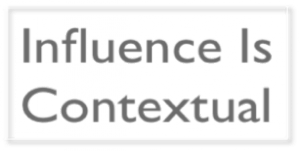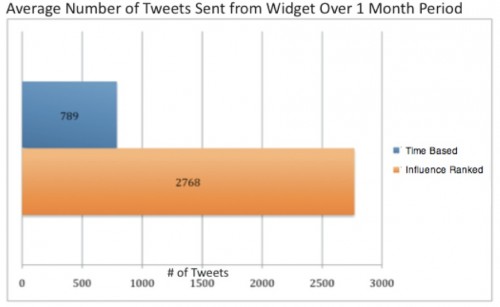Using Influence To Tune Signal To Noise On The Social Web
In this article, we will explore how influence can be used to extract signal and remove noise from search results. With realtime results showing up in lots of publishers’ pages, it’s important to maximize the signal-to-noise ratio in social streams so consumers are exposed to only the most valuable social content. Using influence is the […]
In this article, we will explore how influence can be used to extract signal and remove noise from search results. With realtime results showing up in lots of publishers’ pages, it’s important to maximize the signal-to-noise ratio in social streams so consumers are exposed to only the most valuable social content. Using influence is the most effective way to identify the most important social content, and present it to consumers.
What Is Influence?
Influence has been a hot topic of discussion on blogs and in the media, with several different definitions floating around. We define influence as the likelihood that, each time you say something, people will pay attention.
With this definition, the person who says the most is not the most influential, just as someone who talks a lot at a party may in fact be more boring than influential. Nor is someone who is given the most attention necessarily the most influential –a talk show host may get a lot of attention, but we may not be influenced by much of what he/she says.
The most influential person is someone who may or may not talk much, but whenever that person does speak, we pay attention (like Warren Buffett on finance).
Applying this definition to Twitter, influence does not reward the person with the most followers, or the person who tweets the most.
Rather, influence should measure attention (such as retweets and replies) and be computed based on the degree of such attention given to each individual tweet, quantified to the keyword & domain level.
Influence should also be transitive – it is calculated over several degrees of separation – just like the common-sense definition. Warren Buffett is so influential because he gets attention from other people who are themselves influential.
Some services compute and publish influence scores for Twitter users. Services that publish influence scores typically focus on computing plausible scores for people at a general level of influence, perhaps to broad topical areas, but may not need to calculate influence for people down to the keyword level.
However, if influence is used to rank search results, to make them authoritative and relevant, then an influence score must be calculated on a bigger scale and at a greater level of detail. It means being able to compute influence for any combination of people and keywords/domains.
It means computing influence for people that nobody is ever going to look up, including hundreds of thousands of bots and spammers, because they could all affect search results.
It is important to remember that influence is contextual. You may buy shares in a company Warren Buffett talks about, but you may not necessarily look to him to recommend a Vietnamese restaurant in California, or a family car. Similarly, on the social web, a person may be influential for a particular topic, or a set of keywords (such as “Kinect” or “Birding”), but not at all influential for something else (“Wine Tasting”).
To pull this context requires that you search and index what people are saying so you can identify people who have the most influence on particular keywords relative to other people and other keywords.
Filtering Noise To Increase Engagement
Tens of thousands of sites across the web are streaming social content right now, primarily from Twitter or Facebook, with content typically displayed as a stream of messages matching a keyword query. It may be useful to follow second-by-second streams for an event occurring in real time, but the vast majority of consumers find this type of “social stream of consciousness” distracting after a few seconds of casual observation.
This point was proven by the use and measurement of “streamed” versus “influence-ranked” content deployed by publishers using Topsy.
The publishers, appealing to consumers within the technology sector, ran one group of widgets containing unfiltered time-streamed social content while another group of widgets (on the same pages) displayed influence-ranked content.
Both groups of widgets also had a way to tweet out messages, the key measure of engagement. Results confirmed what you’d expect – quality content matters, with a more than 300 percent increase in engagement rates within the widget containing influence-based results versus the time-streamed results. The chart below shows this increase, with engagement measured in the number of tweets sent from the widget.
More details results from this study can be found here. (PDF)
Clearly, exposing consumers to more relevant social content increases engagement, which, in turn, increases:
- Time on a page
- The likelihood of clicking through on other links to explore content
- Page views
Better content is good for consumers and great for publishers. Ranking content by influence is a very useful way to provide highly relevant social content to consumers.
Use High Fidelity To Turn Up the Social Content Dial
What happens when you turn up the influence dial, ranking and filtering content only by influencers? What’s the quantitative impact of how much content actually goes away and what are the qualitative implications?
To answer the above questions, we ran queries for a variety of keywords over different timeframes to show the number of tweets from influentials versus the number of tweets from non-influentials (all) to understand what impact influence has as a filtering mechanism over time.
We chose keywords from diverse areas to attain an objective view and ran queries extracting the number of tweets referencing each keyword over different timeframes. We compared influence-only content to all other content, meaning any tweet that has been retweeted or contained a URL.
Results
As you can see from the data, filtering social streams by influence significantly lowers the amount of content exposed for each query. And, for results within the past 24 hours, displaying content only by influencers isn’t practical for some queries because the content is too sparse. But, extending the timeframe out past a single day opens up opportunities to display ample content from influencers. It’s worth noting that for most applications, displaying content that is a few days fresh is completely acceptable.
Ultimately, achieving the balance between how much content to display, how tightly the content should be filtered by influence and the timeframe from which the content is extracted comes down to utility. For example, the topic CES was trending at a very high volume in early January so it made sense to look at the past day with a tight influence filter to remove all the noise. And, if I’m interested in CES I’m probably keen to understand what’s being most talking about within the past hour and today.
But, if I’m traveling to San Francisco and want to find out what’s being said about hotels in San Francisco, it’s probably preferred to pull social content from the past few weeks, again filtered by influence, because the time-sensitivity dial doesn’t have to be now or today to get a useful answer.
Overall, being able to quantify the amount of content available from influencers within a specific timeframe provides you with an excellent gauge of how much content is available. Qualitative judgments can then be made by simply viewing the content available within the influence and timeframe parameters selected.
Tune Social Signals To Meet Your Needs
Social networks provide the new search signals on the web. Whether you are a consumer, marketer or publisher, you should be using these signals to your benefit.
- For consumers, this means being able to effectively query the social web to get meaningful answers to your questions.
- Marketers can extract valuable content from the social web to educate consumers about product purchase decisions, empowering them to become more informed before they buy.
- And, publishers should harvest content from the social web for their pages, providing consumers with relevant, fresh content that keeps them engaged and let’s them discover new content within the publisher’s domain.
Each of these applications for social content requires a robust way to not only query social data, but also rank and filter social search results in ways that remove noise. Invoking influence along with time windows into results makes social content meaningful and relevant for consumers, marketers and publishers. It’s important to understand the impact different influence and time window options have on results so you’re able to balance the trade-off between the quantity and quality of results displayed.
Opinions expressed in this article are those of the guest author and not necessarily Search Engine Land. Staff authors are listed here.
Related stories
New on Search Engine Land




